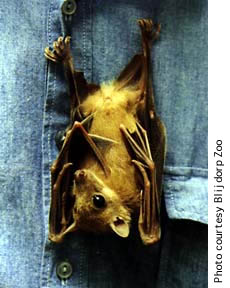

The Egyptian fruit bat
This species was described from a specimen collected in the pyramidsof Egypt, hence the name. Egyptian fruit bats are gregarious and cave-dwelling.Colonies of up to thousands occur. They roost in the darkest parts of thecave, closely packed together, usually hanging by one of the hind feet.Although their eyesight is excellent they can also use echolocation tonavigate in the pitch darkness of caves. They are the only fruit bat knownto echolocate. Low frequency clicks produced by the tongue are used inecholocation. The Egyptian fruit bats echolocate mostly with a constantfrequency from 30 kHz to 80 kHz.
Echolocation--the active use of sonar (SOund Navigation And Ranging)--allowsbats to "see" with sound. Bats use their biosonar in a soundor frequency range that humans cannot hear. Human hearing spans from about200 hertz (or 200 cycles per second) to 20,000 hertz (or 20,000 cyclesper second). Bats can hear well into the ultrasonic range or up to roughly200,000 hertz. The biosonar of most bats operates from about 25,000 to100,000 hertz, abbreviated as 25 to 100 kilohertz or kHz (thousand hertz).
Approximately three hundred Egyptian fruit bats live in the caveat the Blijdorp Zoological Gardens in Rotterdam. The bats are active mostlyin the afternoon when they are fed. In the morning the cave is cleaned.The bats spend most of their time on the left side of the cave, and occasionallyfly to the right side. The public can see the bats through a window. Infront of the window there are two wooden construction beams where the food(bananas, oranges) hangs from. The batbot alsohangs from one these beams.
Back to Kac Web